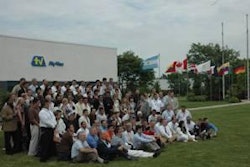Finally we can see a clearer picture of the substantial change that has affected the size of the pig breeding population globally over the past two years. Only now, with the availability of data for inventories in each of the main pork-producing countries at the end of 2008, is it possible to judge the true scale of the fall-out in sow numbers that has occurred after high feed commodity prices and other market pressures took away profits.
This is before the full impact of the current economic recession has been factored into the equation. But the inescapable conclusion from looking at Table 1, extracted from the exclusive database maintained by Pig International, is that few of the 30 largest national herds worldwide succeeded in maintaining their size in 2008 and even fewer achieved any sort of expansion.
Slaughter pig supplies and prices were already offering clues, of course. Although annual sow productivity keeps increasing, no improvement in pigs per sow was going to be enough to compensate for having fewer sows and therefore the number of animals marketed to abattoirs had decreased sharply.
It is a complete contrast to the situation we were describing a year ago. At that time, we said that stability rather than expansion continued to be the indication from the latest figures for sows per country. Nowhere seemed to be showing either a major reduction in sow numbers or a tendency to grow.
Such an analysis seemed completely in line with longer-term trends including the demise of the smallest herds and the consolidation of the larger enterprises. The people with more sows have been less inclined to close or downsize when profitability is poor. But the period 2007-2008 was far from a normal low in a conventional seven-year hog cycle. This time, the sow owners have not kept up their inventory in the hope of better times to come.
However, take a closer look at the table and you will find that there were important exceptions to the general reduction taking place in 2008. Most crucially, due to its enormous size, the pork industry in China stands out for having continued re-building last year after losing about two million sows from the national total in 2006. Chinese government policies are promoting another increase in 2009.
See also the different impression given by comparing 2008 sow numbers with those for 2007 or earlier, according to the relative maturity of the pork production business in that country. The most mature markets are exemplified by the member states of the European Union. Those are represented in the table suffered a drop in their sow count last year and this was particularly true for the countries from centre/east Europe.
Overall, data compiled by the Eurostat statistics bureau say that the EU-27 contained 13.977 million sows on its pig breeding herds at the end of 2008. Twelve months earlier, the total had been 14.904 million or 6.6% more. Back in 2006 it was higher still, at 15.569 million, having climbed from a tally of 15.451 million sows for the same countries in 2005.
For the opposite end of the spectrum take the case of still-growing industries such as those in Vietnam and Russia. By our calculation the Russian number increased by more than 4% during the year and Vietnam’s rose by over 1%. In each instance the national government is pushing hard for more output. Russia wants to be self-sufficient for pork within three years and Vietnam in the same time-frame aims to be the largest exporter of the meat to its neighbouring states.
The changes throughout the list in 2008 give it a new look from the ones we have published in the past. The order of ranking has altered as several countries swapped places. There is even a newcomer, because Sweden replaces Finland at Number 30 for size.

















